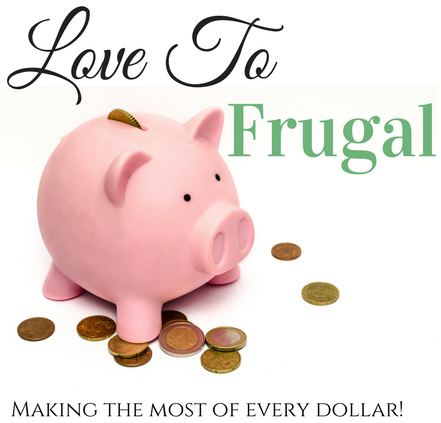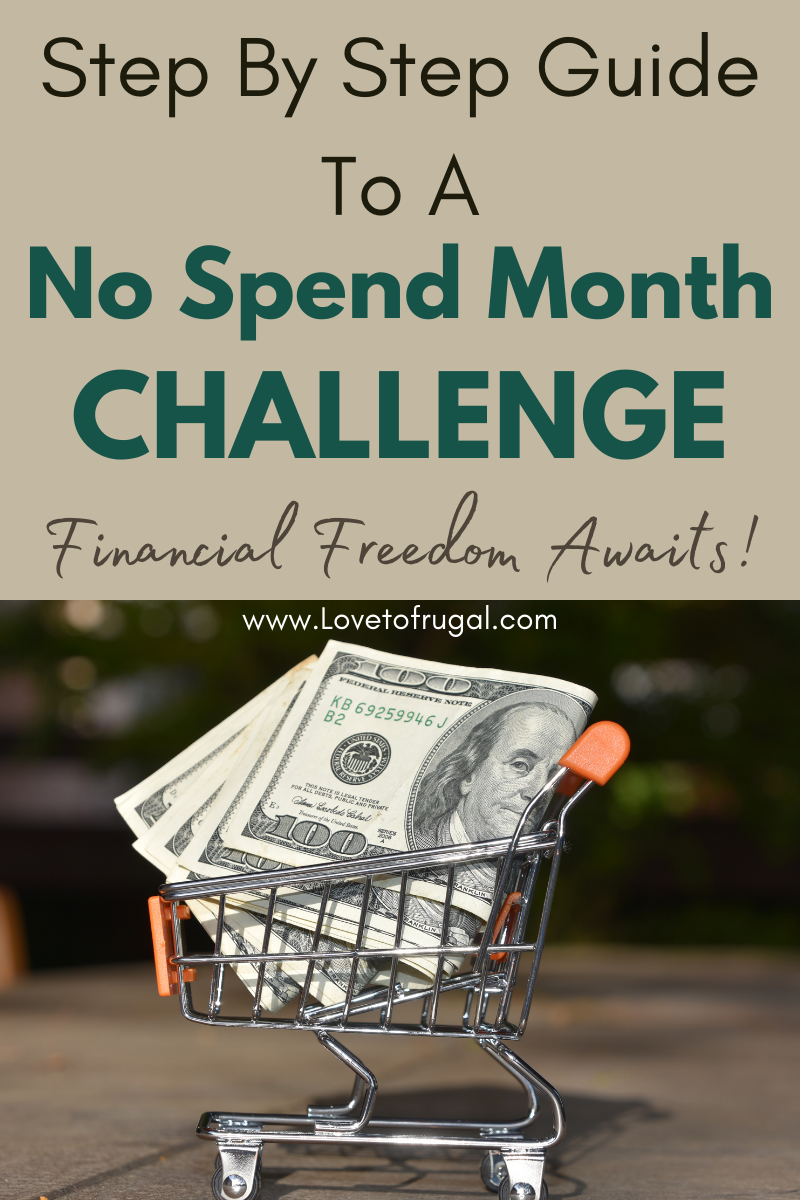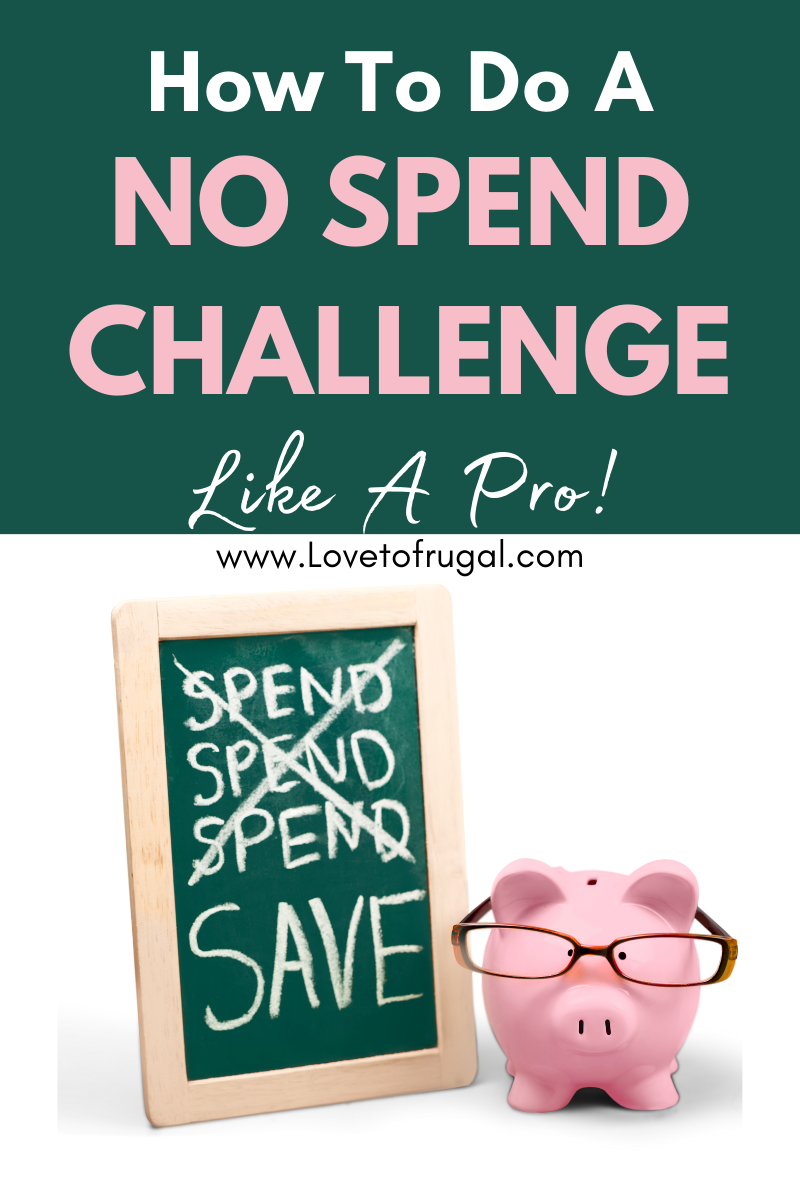How to Do a No Spend Month Challenge
Are you ready to kickstart your financial game with the ultimate no spend month challenge? I know I am!
Picture this: a month where you conquer your spending habits, save big bucks, and emerge as a money-saving champion. Yep, that’s what the ‘no spend month challenge’ is all about – a fun yet rewarding journey to curb non-essential expenses, boost savings, and flex those financial muscles. But hey, don’t worry! It’s not at all about deprivation! It’s a great way to reset your spending mindset and make your wallet smile.
After the holidays, the no spend challenge works like a detox…at least that’s what it felt like to me. December tends to be a very expensive month, so when the new year rolled around, I was done with spending! Last January, I committed to the no spend month challenge to mainly put a buffer in our checking account and you know what? It worked great! I liked it so much that we now do this a few times a year. It’s such a great way to boost savings, add a buffer to the checking account, pay off debt and so much more!
So, if you’re interested in learning more about it and hopefully giving it a try, stick around and we can dive into this no spend month adventure together! I’ll explain in more detail, below.
*This post may contain affiliate links, which means that if you buy a suggested product, I will earn a small commission, at no extra cost to you. For more information, see my disclosure page.
what is a no spend month?
A no spend month is a disciplined commitment to limit spending on non-essential items for an entire month. The primary goal is to focus solely on essential purchases while cutting out unnecessary expenses completely. Like I said above…this isn’t about deprivation; it’s an opportunity for intentional and mindful spending.
The Benefits of a No Spend Month
Undertaking a no spend month challenge can offer various compelling reasons and benefits that make it a valuable experience for individuals looking to revamp their financial habits. Here are several reasons why you should consider participating in a no spend month challenge:
- Financial Awareness: During this challenge, you’ll develop a heightened awareness of your spending patterns. It allows you to differentiate between needs and wants, making you more conscious of where your money goes.
- Savings Boost: By eliminating non-essential spending, you’ll likely save a significant amount in a short period. You can allocate this extra money towards debt repayment, savings, emergency funds, or investments.
- Helps To Reset Financial Priorities: Taking part in the challenge allows you to reassess your financial goals and priorities. It can motivate you to align your spending habits with your long-term financial objectives.
- Improved Money Management Skills: Throughout the challenge, you’ll develop better budgeting skills and strategies for making more informed financial decisions.
- Breaks The Impulse Buying Habits: It’s an opportunity to break free from the cycle of impulse buying. The challenge helps establish a habit of considering purchases carefully rather than succumbing to instant gratification.
- Reduced Clutter and Excess: By avoiding unnecessary purchases, you prevent accumulating more items that might contribute to clutter and excess in your life.
How to Prepare for a No Spend Month
The rules for a no spend month challenge can vary based on personal preferences and goals, but here are common guidelines to follow during this financial challenge:
- Define Your Spending Boundaries: Determine what constitutes essential and non-essential expenses. Essentials typically include basic needs like housing, groceries, utilities, transportation, healthcare, prescriptions and debt payments.
- Know Your Why And Set Clear Goals: Define what you want to achieve during this period. Whether it’s paying off a specific debt, saving a certain amount, or simply reducing unnecessary expenses, having a clear goal will motivate and guide you through the month.
- Assess Your Finances: Review your current financial situation. Analyze income, essential expenses, debts, and any discretionary spending. This evaluation will help in setting realistic goals and budgets for the no spend month challenge.
- Create a Detailed Budget: Start by listing all essential expenses, such as rent/mortgage, utilities, groceries, transportation, and insurance. Allocate funds for these necessities while cutting out any non-essential spending categories like dining out, entertainment, or shopping.
- No Spending on Non-Essentials: Commit to avoiding purchases of non-essential items or services during the entire month. This includes eating out, entertainment expenses, clothing, unnecessary gadgets, coffee shops, home decor and other discretionary purchases.
- Plan Ahead: Prepare in advance by stocking up on essential items like groceries, toiletries, and household supplies before starting the challenge. This minimizes the need for additional purchases during the month. In other words, try to stay away from the stores as much as possible.
- Avoid Impulse Buying: Refrain from impulse purchases or unplanned expenses. Before making any purchase, pause and consider if it’s a genuine necessity or a discretionary expense.
- Use What You Have: Embrace resourcefulness and use what you already own. Repurpose items, cook meals at home with existing ingredients, and find free or low-cost entertainment options.
- Stay Accountable: Keep track of all your expenses throughout the month. Maintain a record of every transaction to monitor adherence to your budget and stay accountable to your spending boundaries.
- Problem-Solve Without Spending: When faced with challenges or unexpected situations, seek solutions that don’t involve spending money. Look for alternatives, borrow or DIY instead of purchasing new items.
- Reflect and Learn: At the end of the challenge, evaluate your experience. Reflect on what worked, what didn’t, and what you learned about your spending habits. Use this insight to make positive changes in the future.
- Communication Is Key: Inform friends, family, or anyone you share expenses with about your commitment to a no spend month. This will help manage expectations and reduce potential social pressure to spend.
what are the essentials?
During a no spend month, it’s crucial to distinguish between essentials and non-essentials to successfully stick to your budget. Essentials are the basic items and expenses necessary for maintaining your well-being and fulfilling obligations. Here’s a breakdown of essentials that you might consider during a no spend month:
- Housing: Rent or mortgage payments are typically essential expenses. Utility bills such as electricity, water, gas, and internet may also fall into this category.
- Groceries: Basic food items needed for sustenance are essential. Focus on purchasing essential groceries that allow you to prepare meals at home. Plan meals ahead to minimize food waste and unnecessary purchases.
- Transportation: Expenses related to commuting to work, such as fuel, public transportation fares, or car maintenance, might be considered essential if required for employment.
- Insurance and Health Care: Health insurance premiums, medical expenses, and essential medications are vital for maintaining health and well-being.
- Debt Payments: If you have debts, making minimum payments or sticking to a predetermined debt repayment plan is essential to avoid penalties and maintain a good credit score.
- Basic Personal Care Items: Necessary personal care items like toiletries (toothpaste, soap, shampoo) and hygiene products are considered essentials.
- Utilities and Subscriptions: Essential services like electricity, water, and internet subscriptions necessary for work or critical communication might be considered essential. However, consider minimizing non-essential subscriptions during the no spend month.
- Childcare and Education: Expenses related to essential childcare or education for your children are typically considered essential.
- Emergency Expenses: Unexpected emergencies or urgent repairs that impact safety or essential functionality may be considered essential.
It’s important to assess your individual circumstances and determine what constitutes an essential expense for you and your family during the no spend month. Prioritize spending on necessities while temporarily eliminating or reducing non-essential expenses to stay within your budget and successfully complete the challenge.
what are the non essentials?
During a no spend month, non-essential expenses are discretionary purchases or optional items that aren’t vital for your basic needs or obligations. These are the expenditures that can be eliminated or significantly reduced to adhere to the challenge. Here’s a breakdown of non-essential expenses you might consider avoiding during a no spend month:
- Dining Out and Takeout: Meals at restaurants, fast food, or ordering takeout are non-essential during this period. Focus on cooking meals at home to save money.
- Entertainment: Expenses related to movies, concerts, theater shows, streaming subscriptions, or other entertainment activities are non-essential. Look for free or low-cost entertainment alternatives.
- Non-Essential Shopping: You should avoid any non-essential shopping for clothing, accessories, gadgets, home decor, or luxury items during the no spend month.
- Hobbies and Activities with Costs: Participation in hobbies or activities that require spending money, such as gym memberships, craft supplies, or equipment rentals, can be considered non-essential.
- Travel and Vacations: Trips, vacations, or travel-related expenses are non-essential during the no spend month.
- Impulse Purchases: You should also avoid any spontaneous or impulse purchases that aren’t necessary for your well-being or obligations.
- Luxury Services: Services like spa treatments, beauty salons, massages, or other luxury services are non-essential.
- Upgrades or Non-Urgent Repairs: Upgrading gadgets, home renovations, or non-urgent repairs that aren’t necessary for safety or essential functionality fall into the non-essential category.
- Subscriptions and Memberships: Non-essential subscriptions or memberships to services like subscription boxes, premium memberships, or extra streaming services can be temporarily paused or canceled.
- Non-Urgent Home Décor or Furnishings: Purchases related to home decor, furniture, or non-essential home improvements can be postponed.
Remember, the definition of non-essential expenses may vary based on individual circumstances and priorities. During a no spend month challenge, the goal is to prioritize spending on necessities while intentionally cutting out or minimizing discretionary expenses to save money and achieve your financial goals.
Strategies for Success During a No Spend Month
- Practice Mindfulness in Spending: Before making any purchase, ask yourself whether it’s a necessity or a want. Consider the long-term benefits of abstaining from non-essential spending and whether the item is crucial to your well-being.
- Explore Free Activities: Seek out free or low-cost entertainment options such as exploring nature, visiting local museums on free admission days, attending community events, or organizing game nights with friends.
- Embrace DIY and Resourcefulness: Instead of buying, try making things yourself. Prepare meals at home, brew your coffee, mend clothes, or create DIY household items. This not only saves money but also hones your skills and creativity.
- Stay Accountable Through Tracking: Monitor and track your spending diligently throughout the month. Use budgeting apps, spreadsheets, or a pen-and-paper method to record every expense. This practice helps you stay within your budget and ensures you’re sticking to your commitment.
Reflect and Celebrate Your Achievements
At the conclusion of your no spend month, take time to reflect on the experience. Celebrate your successes, whether big or small, and assess what you’ve learned about your spending habits. Use this insight to continue making positive changes in your financial life moving forward.
I got fairly detailed in this blog post because I wanted to provide step-by-step instructions and strategies for individuals who maybe considering a no spend month. This challenge can work wonders for your finances and if you can implement these suggestions and stay committed to the challenge, you’ll not only achieve financial goals but also gain a deeper understanding of your relationship with money and spending habits.
I also want you to remember that you can do a no spend challenge at any time. January is usually the most popular time because most of us are suffering from the old Christmas hangover. But, any time you need to reset your finances, this is the perfect opportunity to do so.
Don’t think you can do a month? No problem! Try a week or two until you get the hang of it and then you can challenge yourself further.
Be sure to subscribe to Love To Frugal so you never miss a post and make sure to follow me on Pinterest, Instagram & Facebook for even more money saving, frugal living tips!



